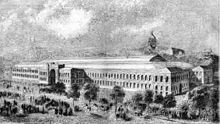Exposition Universelle (1855)
| Exposition Universelle des produits de l'Agriculture, de l'Industrie et des Beaux-Arts de Paris 1855 | |
|---|---|
 Palais de l'industrie | |
| Overview | |
BIE-class | Universal exposition |
| Category | Historical Expo |
| Name | Exposition Universelle des produits de l'Agriculture, de l'Industrie et des Beaux-Arts de Paris 1855 |
| Building | Palais de l'Industrie |
| Area | 15,2 ha |
| Visitors | 5,162,330 |
| Participant(s) | |
| Countries | 27 |
| Location | |
| Country | France |
| City | Paris |
| Venue | Jardins des Champs Elysees |
| Coordinates | 48°52′0″N 2°18′47″E / 48.86667°N 2.31306°E / 48.86667; 2.31306 |
| Timeline | |
| Opening | 15 May 1855 (1855-05-15) |
| Closure | 15 November 1855 (1855-11-15) |
| Universal expositions | |
| Previous | The Great Exhibition in London |
| Next | 1862 International Exhibition in London |
The Exposition Universelle of 1855 was an International Exhibition held on the Champs-Élysées in Paris from 15 May to 15 November 1855. Its full official title was the Exposition Universelle des produits de l'Agriculture, de l'Industrie et des Beaux-Arts de Paris 1855.[1] Today the exposition's sole physical remnant is the Théâtre du Rond-Point des Champs-Élysées designed by architect Gabriel Davioud, which originally housed the Panorama National.
Contents
1 History
2 References
3 Further reading
4 External links
History
The exposition was a major event in France, then newly under the reign of Emperor Napoleon III.[2] It followed London's Great Exhibition of 1851 and attempted to surpass that fair's Crystal Palace with its own Palais de l'Industrie.
The arts displayed were shown in a separate pavilion on Avenue Montaigne.[3] There were works from artists from 29 countries, including French artists Francois Rude, Ingres, Delacroix[3] and Henri Lehmann,[4] and British artists William Holman Hunt and John Everett Millais.[3]
According to its official report, 5,162,330 visitors attended the exposition, of which about 4.2 million entered the industrial exposition and 0.9 million entered the Beaux Arts exposition.[1] Expenses amounted to upward of $5,000,000, while receipts were scarcely one-tenth of that amount. The exposition covered 16 hectares (40 acres) with 34 countries participating.[1]
For the exposition, Napoleon III requested a classification system for France's best Bordeaux wines which were to be on display for visitors from around the world. Brokers from the wine industry ranked the wines according to a château's reputation and trading price, which at that time was directly related to quality. The result was the important Bordeaux Wine Official Classification of 1855.[5]
References
^ abc Exposition Universelle. "1855, exposition universelle des produits de l'agriculture, de l'industrie et des beaux-arts". Exposition Universelle. Retrieved 9 January 2012..mw-parser-output cite.citation{font-style:inherit}.mw-parser-output q{quotes:"""""""'""'"}.mw-parser-output code.cs1-code{color:inherit;background:inherit;border:inherit;padding:inherit}.mw-parser-output .cs1-lock-free a{background:url("//upload.wikimedia.org/wikipedia/commons/thumb/6/65/Lock-green.svg/9px-Lock-green.svg.png")no-repeat;background-position:right .1em center}.mw-parser-output .cs1-lock-limited a,.mw-parser-output .cs1-lock-registration a{background:url("//upload.wikimedia.org/wikipedia/commons/thumb/d/d6/Lock-gray-alt-2.svg/9px-Lock-gray-alt-2.svg.png")no-repeat;background-position:right .1em center}.mw-parser-output .cs1-lock-subscription a{background:url("//upload.wikimedia.org/wikipedia/commons/thumb/a/aa/Lock-red-alt-2.svg/9px-Lock-red-alt-2.svg.png")no-repeat;background-position:right .1em center}.mw-parser-output .cs1-subscription,.mw-parser-output .cs1-registration{color:#555}.mw-parser-output .cs1-subscription span,.mw-parser-output .cs1-registration span{border-bottom:1px dotted;cursor:help}.mw-parser-output .cs1-hidden-error{display:none;font-size:100%}.mw-parser-output .cs1-visible-error{font-size:100%}.mw-parser-output .cs1-subscription,.mw-parser-output .cs1-registration,.mw-parser-output .cs1-format{font-size:95%}.mw-parser-output .cs1-kern-left,.mw-parser-output .cs1-kern-wl-left{padding-left:0.2em}.mw-parser-output .cs1-kern-right,.mw-parser-output .cs1-kern-wl-right{padding-right:0.2em}
^ Art Nouveau. "L' Exposition Universelle de 1855 à Paris". L'art nouveau. Retrieved 9 January 2011.
^ abc
Ratcliffe, Barrie M, "Paris 1855", in Findling, John E; Pelle, Kimberley D, Encyclopedia of World's Fairs and Expositions, McFarland & Company, Inc, p. 23, ISBN 978-0-7864-3416-9
^ Océanides grief of the foot of the rock where Prometheus was chained, Fitzwilliam Museum, 2014
^ Peppercorn, David (2003). Bordeaux. London: Mitchell Beazley. p. 83. ISBN 1-84000-927-6.
Further reading
- Elizabeth M. L. Gralton, "Lust of the Eyes: The Anti-Modern Critique of Visual Culture at the Paris Expositions universelles, 1855-1900," French History & Civilization (2014), Vol. 5, pp 71-81
 This article incorporates text from a publication now in the public domain: Gilman, D. C.; Peck, H. T.; Colby, F. M., eds. (1905). "article name needed". New International Encyclopedia (1st ed.). New York: Dodd, Mead.
This article incorporates text from a publication now in the public domain: Gilman, D. C.; Peck, H. T.; Colby, F. M., eds. (1905). "article name needed". New International Encyclopedia (1st ed.). New York: Dodd, Mead.
External links
| Wikimedia Commons has media related to Exposition Universelle (1855). |
- Official website of the BIE
- Rapport sur l’exposition universelle de 1855 (official report, published 1856, in French)
- Fanfare for the New Empire
- ExpoMuseum
